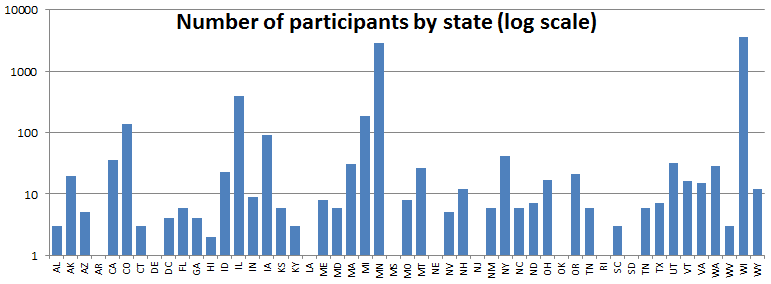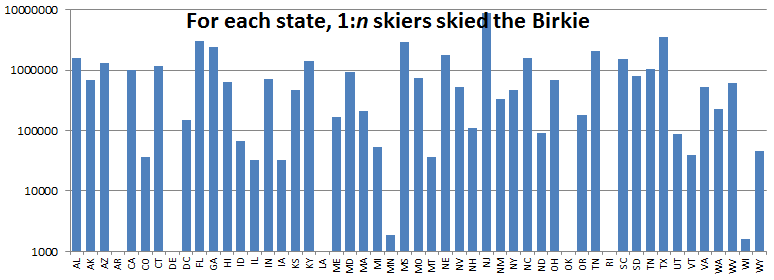
Ari's Unofficial Guide to the Birkie
2011 geography statistics.
Charts: Age, Gender, Geography, By wave: Birkie Freestyle, Birkie Classic, Korteloppet Freestyle, Korteloppet Classic, 2011 statistics index
Data: State data for all finishers, state "competitions", "Special data" search
Everyone comes from somewhere to ski the Birkie. But some people come further than others:
Where did racers come from? Skiers this year came from 18 countries and 45 states plus the District of Columbia (missing were representatives from Arkansas, Delaware, Louisiana, Oklahoma and Rhode Island). Amongst the big two, Wisconsin edged out Minnesota for overall participation, followed by Illinois, Michigan and Colorado (137 Coloradans made the trip, by far the leading non-border state!).

"You ski the Birkie, you're one in a million!" For residents of many states, that's a factual statement. The following chart shows the number ratio of Birkie skiers to non-Birkie skiers for each state. In other words, the chart below can complete the statement: "In [state], for every person who skied the Birkie, [large number] people did not."

For Minnesota and Wisconsin, more than one in every 2000 people ski the Birkie. A geographically diverse bunch states have ratios between 1:30,000 and 1:40,000: Alaska, Colorado, Illinois, Iowa, Montana and Vermont all fall in this same ballpark. Big states suffer here, even if they have snow. There's a sizeable contigent from California, with three dozen skiers, but that's still fewer than one in a million. And the winner (or, loser)? Well, obviously, the five states which sent no one to Cable. But of states with participants one rose well above the rest and it wasn't close: New Jersey had one participant out of 8.7 million. Fuggedaboutit.
(Also, six Floridians? Two Hawai'ians? Where are these people training?! Sand skiing perhaps?)
How far do people travel? Pretty far, actually. Since not too many people actually live in Hawyard, Seeley or Cable, most folks have to drive. Or fly. The data here is only for folks from the United States and Canada, calculated as the straight-line distance from their ZIP code to the start line. With many skiers coming from cities, peaks definitely show up, first for Duluth, then for the Twin Cities, and, further afield for Madison, Milwaukee and Chicago. There are not a lot of skiers from the 400-600 mile range away, but participants pick up in chunks as other ski hotbeds, first the Rockies and the northeast, then the Pacific Northwest and California, are reached in ever broadening circles. Alaska spikes up over 2000 miles away, and then there are the two participants from Hawai'i!

Charts: Age, Gender, Geography, By wave: Birkie Freestyle, Birkie Classic, Korteloppet Freestyle, Korteloppet Classic, 2011 statistics index
Data: State data for all finishers, state "competitions", "Special data" search
© 2010-2011, Ari Ofsevit / birkieguide.com
This site is in no way affiliated with the American Birkebeiner Ski Foundation, the Birkebeiner or the Birkie. But it is a huge Birkie fanboy.
Ski, cross country ski, nordic ski